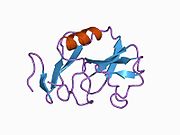Biology:KLRD1
 Generic protein structure example |
CD94 (Cluster of Differentiation 94), also known as killer cell lectin-like receptor subfamily D, member 1 (KLRD1) is a human gene.[1]
The protein encoded by CD94 gene is a lectin, cluster of differentiation and a receptor that is involved in cell signaling and is expressed on the surface of natural killer cells in the innate immune system. CD94 pairs with the NKG2 molecule as a heterodimer. The CD94/NKG2 complex, on the surface of natural killer cells interacts with Human Leukocyte Antigen (HLA)-E on target cells.
Function
Natural killer (NK) cells are a distinct lineage of lymphocytes that mediate cytotoxic activity and secrete cytokines upon immune stimulation. Several genes of the C-type lectin superfamily, including members of the NKG2 family, are expressed by NK cells and may be involved in the regulation of NK cell function. KLRD1 (CD94) is an antigen preferentially expressed on NK cells and is classified as a type II membrane protein because it has an external C terminus. KLRD1 has two alternatively spliced variants that differ in the presence or absence of exon 2 sequence.[1]
Interactions
KLRD1 has been shown to interact with KLRC2.[2][3]
See also
- Cluster of differentiation
- CD94/NKG2
References
- ↑ 1.0 1.1 "Entrez Gene: KLRD1 killer cell lectin-like receptor subfamily D, member 1". https://www.ncbi.nlm.nih.gov/sites/entrez?Db=gene&Cmd=ShowDetailView&TermToSearch=3824.
- ↑ "Human natural killer cell receptors involved in MHC class I recognition are disulfide-linked heterodimers of CD94 and NKG2 subunits". Journal of Immunology 157 (11): 4741–5. Dec 1996. doi:10.4049/jimmunol.157.11.4741. PMID 8943374.
- ↑ "Direct binding of purified HLA class I antigens by soluble NKG2/CD94 C-type lectins from natural killer cells". Scandinavian Journal of Immunology 49 (5): 459–65. May 1999. doi:10.1046/j.1365-3083.1999.00566.x. PMID 10320637.
Further reading
- "Molecular characterization of human CD94: a type II membrane glycoprotein related to the C-type lectin superfamily". European Journal of Immunology 25 (9): 2433–7. Sep 1995. doi:10.1002/eji.1830250904. PMID 7589107.
- "Human natural killer cell receptors for HLA-class I molecules. Evidence that the Kp43 (CD94) molecule functions as receptor for HLA-B alleles". The Journal of Experimental Medicine 180 (2): 545–55. Aug 1994. doi:10.1084/jem.180.2.545. PMID 8046333.
- "CD94 and a novel associated protein (94AP) form a NK cell receptor involved in the recognition of HLA-A, HLA-B, and HLA-C allotypes". Immunity 5 (2): 163–72. Aug 1996. doi:10.1016/S1074-7613(00)80492-6. PMID 8769479.
- "Human natural killer cell receptors involved in MHC class I recognition are disulfide-linked heterodimers of CD94 and NKG2 subunits". Journal of Immunology 157 (11): 4741–5. Dec 1996. doi:10.4049/jimmunol.157.11.4741. PMID 8943374.
- "NKG2A complexed with CD94 defines a novel inhibitory natural killer cell receptor". The Journal of Experimental Medicine 185 (4): 795–800. Feb 1997. doi:10.1084/jem.185.4.795. PMID 9034158.
- "Multiple receptors for HLA-G on human natural killer cells". Proceedings of the National Academy of Sciences of the United States of America 94 (26): 14666–70. Dec 1997. doi:10.1073/pnas.94.26.14666. PMID 9405670. Bibcode: 1997PNAS...9414666M.
- "Structure of the human CD94 C-type lectin gene". Immunogenetics 47 (4): 305–9. Mar 1998. doi:10.1007/s002510050362. PMID 9472066.
- "Inhibition of antigen-induced T cell response and antibody-induced NK cell cytotoxicity by NKG2A: association of NKG2A with SHP-1 and SHP-2 protein-tyrosine phosphatases". European Journal of Immunology 28 (1): 264–76. Jan 1998. doi:10.1002/(SICI)1521-4141(199801)28:01<264::AID-IMMU264>3.0.CO;2-O. PMID 9485206.
- "HLA-E binds to natural killer cell receptors CD94/NKG2A, B and C". Nature 391 (6669): 795–9. Feb 1998. doi:10.1038/35869. PMID 9486650. Bibcode: 1998Natur.391..795B.
- "Sequence analysis of a 62-kb region overlapping the human KLRC cluster of genes". Genomics 49 (2): 193–9. Apr 1998. doi:10.1006/geno.1997.5197. PMID 9598306.
- "An alternatively spliced form of the human CD94 gene". Immunogenetics 48 (1): 87–8. Jun 1998. doi:10.1007/s002510050407. PMID 9601951.
- "Association of DAP12 with activating CD94/NKG2C NK cell receptors". Immunity 8 (6): 693–701. Jun 1998. doi:10.1016/S1074-7613(00)80574-9. PMID 9655483.
- "Mouse CD94/NKG2A is a natural killer cell receptor for the nonclassical major histocompatibility complex (MHC) class I molecule Qa-1(b)". The Journal of Experimental Medicine 188 (10): 1841–8. Nov 1998. doi:10.1084/jem.188.10.1841. PMID 9815261.
- "Specific recognition of HLA-E, but not classical, HLA class I molecules by soluble CD94/NKG2A and NK cells". Journal of Immunology 162 (1): 305–13. Jan 1999. doi:10.4049/jimmunol.162.1.305. PMID 9886400.
- "Structure of CD94 reveals a novel C-type lectin fold: implications for the NK cell-associated CD94/NKG2 receptors". Immunity 10 (1): 75–82. Jan 1999. doi:10.1016/S1074-7613(00)80008-4. PMID 10023772.
- "Triggering of effector functions on a CD8+ T cell clone upon the aggregation of an activatory CD94/kp39 heterodimer". Journal of Immunology 162 (7): 3996–4002. Apr 1999. doi:10.4049/jimmunol.162.7.3996. PMID 10201920.
- "Direct binding of purified HLA class I antigens by soluble NKG2/CD94 C-type lectins from natural killer cells". Scandinavian Journal of Immunology 49 (5): 459–65. May 1999. doi:10.1046/j.1365-3083.1999.00566.x. PMID 10320637.
- "Expression of CD94 and NKG2 molecules on human CD4(+) T cells in response to CD3-mediated stimulation". Journal of Leukocyte Biology 70 (2): 219–24. Aug 2001. doi:10.1189/jlb.70.2.219. PMID 11493613.
- "Conservation and variation in human and common chimpanzee CD94 and NKG2 genes". Journal of Immunology 168 (1): 240–52. Jan 2002. doi:10.4049/jimmunol.168.1.240. PMID 11751968.
- "Differential involvement of CD40, CD80, and major histocompatibility complex class I molecules in cytotoxicity induction and interferon-gamma production by human natural killer effectors". Journal of Leukocyte Biology 72 (2): 305–11. Aug 2002. doi:10.1189/jlb.72.2.305. PMID 12149421.
External links
- CD94+Antigen at the US National Library of Medicine Medical Subject Headings (MeSH)
 |


